AIaaS vs SDaaS in 2025: Differences, advantages, and examples
Have you ever wondered how some companies seem to have all the answers without doing everything themselves? These days, businesses are finding smart ways to get the skills and tools they need—without having to build it all in-house.
Two models are getting a lot of attention as we move into 2025: Artificial Intelligence as a Service (AIaaS) and Software Development as a Service (SDaaS). Both make life easier by giving companies flexibility and expert help—but they solve very different business challenges.
So, what’s the difference between them? Why are so many businesses trying them out? And which one might actually work for your organization? Let’s take a closer look.
What is Artificial Intelligence as a Service (AIaaS)?
Artificial Intelligence as a Service, or AIaaS, means businesses can access ready-made AI tools and infrastructure through subscription-based platforms, instead of developing AI systems from scratch. Think of it like renting AI instead of building your own lab. For example, if you’re running an e-commerce company and you want to introduce personalized recommendations for your customers, you don’t have to create your own machine learning model. Instead, you can pay for access to an AIaaS provider that already has the tools ready to plug into your system.
AIaaS platforms usually cover services like:
- Machine learning models on demand: From predictive analytics to recommendation engines.
- Natural Language Processing (NLP): Tools like chatbots, sentiment analysis, or automated customer support.
- Computer vision: Image recognition, facial detection, and video analytics.
- AI infrastructure: Cloud computing power and storage to train models at scale.
Popular AIaaS providers include platforms like Amazon Web Services AI, Google Cloud AI, and Microsoft Azure AI. The beauty of AIaaS lies in its accessibility. Small startups and large corporations alike can use AI without hiring a full in-house data science team or building expensive infrastructure.
What is Software Development as a Service (SDaaS)?
On the other hand, SDaaS is all about software creation itself. Instead of outsourcing one-time projects, businesses can tap into flexible, subscription-style partnerships for their software development needs. Think of it as having a development team on call, ready to build, scale, or improve your applications as your business evolves.
SDaaS typically comes in three flavors:
- Developer as a Service: Hiring skilled developers on demand to join your existing team.
- Application Development as a Service: Delegating entire web or mobile app projects from design to launch.
- Software Engineering as a Service: Outsourcing high-maintenance tasks like DevOps, QA, or support.
Imagine you’re a healthcare startup preparing to launch a new telehealth platform. Instead of spending months recruiting developers, you could bring in a full SDaaS team that already has experience with healthcare tech and compliance requirements. This lets you hit deadlines faster, save money, and scale development up or down as needed.
Breaking down AIaaS. How does it work?
AIaaS works in a very similar way, but instead of developers, you’re “renting” access to powerful AI tools and infrastructure. Picture it like subscribing to Netflix—but instead of movies, you’re streaming advanced machine learning models, chatbots, and analytics. You don’t need to hire data scientists or buy expensive servers to get started.
Here’s what the process usually looks like:
- Choosing your tool: You pick the AI service that matches your business need—maybe it’s a chatbot for customer support, a predictive model for sales forecasting, or image recognition for quality checks.
- Integration: The provider makes it easy to plug their tools into your existing systems through APIs or pre-built platforms.
- Subscription setup: Just like signing up for any service, you agree on usage levels and pricing. Most AIaaS platforms charge you only for what you use.
- Ongoing use and scaling: As your business grows, you can increase your usage or add more AI features. No need to rebuild anything from scratch—it’s already there waiting for you.
In short, AIaaS is like borrowing a supercomputer brain when you need it, without paying to own the whole thing.
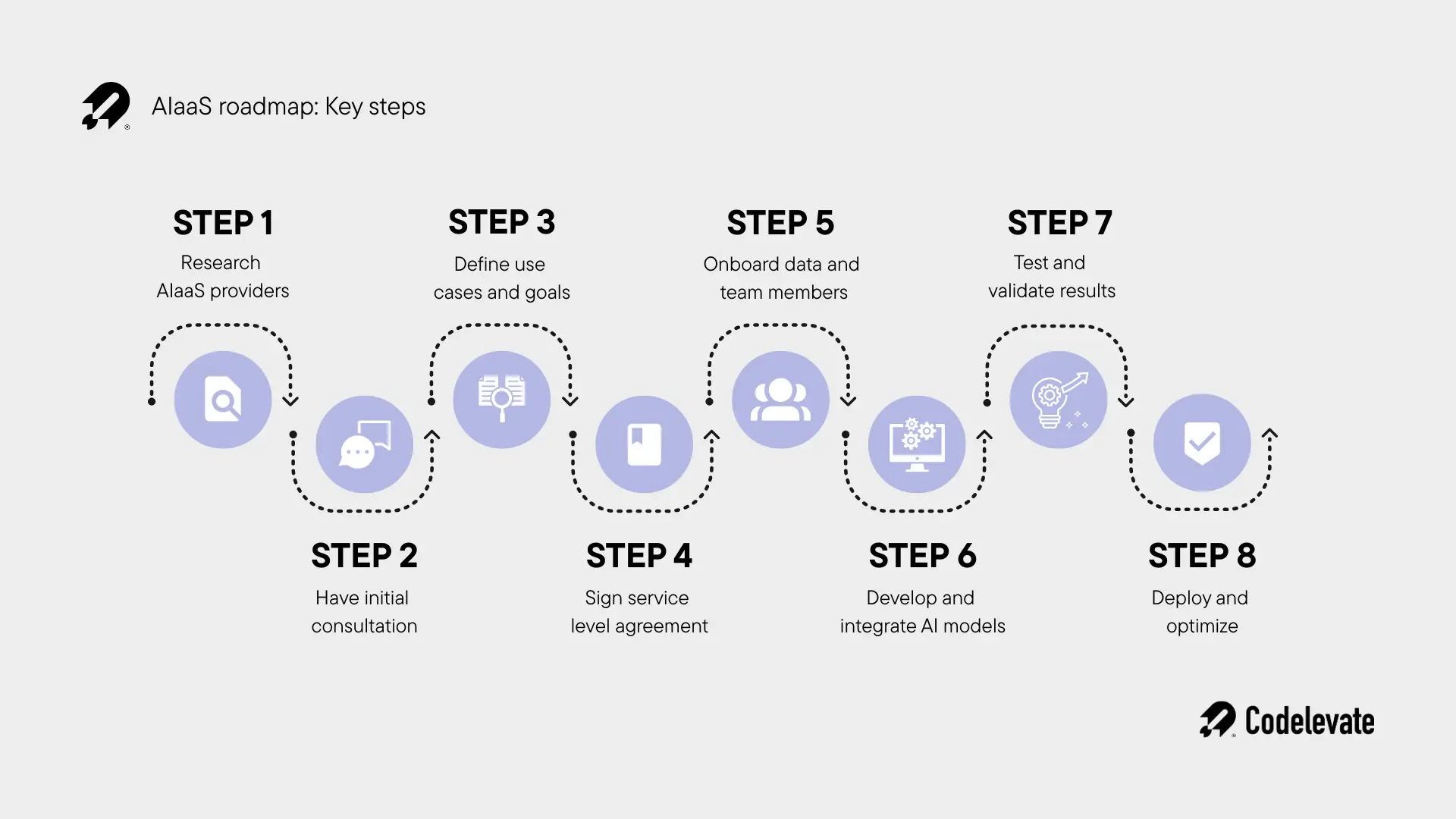
Breaking down SDaaS. How does it work?
Think of SDaaS like having an on-demand software team in your back pocket. Instead of hiring full-time developers or running an entire in-house IT department, you bring in experts only when you need them. Sometimes you might just need one or two developers to join your team. Other times, you might hand over an entire project to a dedicated crew. The beauty is flexibility—you scale up or down depending on your workload.
Here’s how it usually plays out:
- Kick-off and scoping: First, you sit down with the provider for a chat. This is where you explain your project goals, ask questions, and get a sense of how they work. They might even use offshore teams to keep costs lower.
- Agreement time: Once you’re both on the same page, you sign a Service Level Agreement (SLA). This basically sets expectations—timelines, deliverables, responsibilities, and what happens if something doesn’t go as planned.
- Onboarding the team: Depending on your project, you might get access to project managers, designers, developers, testers, or just a couple of specialists to join your existing team.
- Building and feedback: The team gets to work—designing, coding, testing, and deploying your software. Throughout the process, you stay involved by giving feedback, so tweaks happen in real time instead of months later.
It’s a bit like renting a fully equipped workshop whenever you need it, instead of building one from scratch.
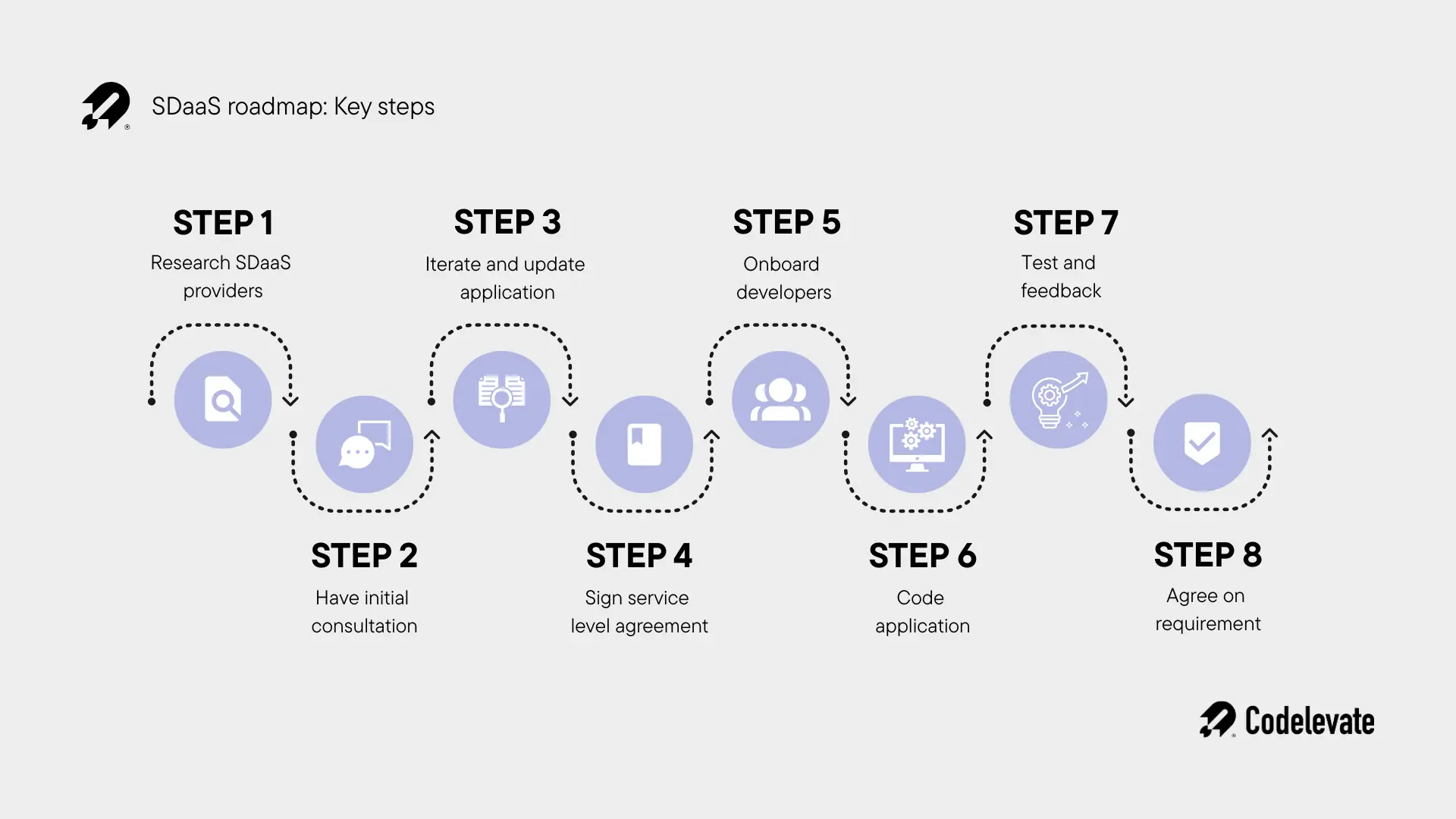
The impact of AIaaS on traditional outsourcing
The same story applies to AIaaS. In the past, if you wanted AI capabilities, you’d typically outsource the entire thing to a specialized vendor who built custom models just for you. That process was expensive, time-consuming, and often hard to maintain. AIaaS flips that model on its head. Instead of paying for a one-time AI project, you subscribe to ready-to-use AI services that slot right into your business. It’s not just about buying a solution—it’s about ongoing access. Your provider keeps the AI tools updated, scales them as your business grows, and ensures you’re not left behind as technology evolves. So while outsourcing was more like a contractor doing a job for you, AIaaS is more like leasing a high-tech toolkit that’s always improving. The real value comes from that continuous partnership, where you’re not just solving today’s problems but staying ready for tomorrow’s challenges too.
.webp)
The impact of SDaaS on traditional outsourcing
You might be thinking, “Wait a second, isn’t Software Development as a Service just another name for outsourcing?” At first glance, they do look similar—both let you bring in outside experts to build custom software without hiring a big in-house team. But here’s the difference: traditional outsourcing usually ends when the project ends. You hand over a task, get it delivered, and that’s that. With SDaaS, it’s more like having a long-term partner who grows with you. Instead of focusing on one-off tasks, the SDaaS provider gets deeply involved in your processes and business goals. They don’t just build an app and walk away—they stick around for updates, scaling, new features, and ongoing support. In other words, SDaaS feels less like outsourcing and more like extending your own team. It blends elements of other service models you already know, like SaaS, IaaS, and PaaS, but applies them to the development process itself. That’s what makes it a more modern, strategic approach.
.webp)
Why are both models thriving in 2025
The reason AIaaS and SDaaS are growing so quickly boils down to three factors: talent shortages, rising costs, and the speed of innovation. According to Statista’s IT talent gap report over 75% of IT leaders still cite a lack of tech talent as a critical bottleneck. Whether it’s AI engineers or software developers, skilled professionals are scarce and expensive. Both AIaaS and SDaaS help companies sidestep this issue by giving them access to ready-made solutions and external expertise. At the same time, businesses face increasing pressure to innovate faster. Customers expect smarter products, seamless apps, and hyper-personalized services. Without flexible service models, many organizations simply cannot keep up.
Comparing AIaaS and SDaaS: Key differences
While both models provide “as-a-service” flexibility, they cater to different needs. Here’s how they stack up against each other:
- Purpose and use case
- AIaaS helps companies leverage AI without building everything in-house. It’s about using intelligent tools to automate processes, analyze data, and provide smarter experiences.
- SDaaS focuses on the actual creation of software. It’s about having developers and engineers on demand to build applications, websites, or platforms.
- Accessibility
- AIaaS works well for businesses of any size, even those without technical teams, because providers make AI tools easy to plug in.
- SDaaS requires closer collaboration since the development process is tailored to your business and projects.
- Cost model
- AIaaS often follows a usage-based model (you pay for how much you use the AI tools).
- SDaaS generally works on a subscription or retainer basis for ongoing development support.
- Long-term value
- AIaaS shines when it comes to analytics, automation, and enhancing customer experiences. It’s a way to stay competitive with AI trends without massive investment.
- SDaaS delivers long-term business value by ensuring your digital infrastructure—apps, systems, and products—can scale and evolve.
Why choose AIaaS to boost business value?
Artificial Intelligence as a Service shines in a slightly different way. It’s not about building software from scratch but about giving your business instant access to smart technology that would otherwise take years to develop in-house. Here’s why companies lean into AIaaS:
- Stay focused on your goals
Instead of hiring data scientists or setting up huge server farms, you simply subscribe to AI services that fit your needs. Your team can keep running the business while AI handles the heavy lifting in the background.
- Quick implementation
Want to launch a chatbot, add personalized recommendations, or predict customer demand? With AIaaS, you can get these features running in weeks instead of years because the models are already built and ready to plug in.
- Scalability without stress
As your business grows, so can your AI. Providers let you scale up usage or add new features without rebuilding your systems. It’s a “pay for what you need” setup that grows with you.
- Cost-effective intelligence
AI talent is scarce and expensive, but AIaaS removes that barrier. Instead of spending millions on internal AI projects, you pay for access to services like Google Cloud AI or IBM Watson that are always being updated and improved.
- Cutting-edge solutions
Since AIaaS providers constantly refine their tools, you automatically benefit from the latest innovations in natural language processing, computer vision, and predictive analytics—without having to chase every new trend yourself.
- Ongoing partnership
Just like with SDaaS, AIaaS is not a one-off purchase. It’s a continuous relationship where your provider updates and maintains the AI features for you, so you’re always a step ahead.
Why choose SDaaS to boost business value?
The biggest reason companies turn to Software Development as a Service is simple: it makes life easier while helping the business grow. Instead of stretching your in-house team thin, you get access to a group of specialists who can jump in exactly when you need them. Here’s why SDaaS is such a strong choice:
- Focus on your real business
If your marketing or operations team is constantly testing apps, submitting tickets, or fiddling with bugs, that’s time stolen from their actual jobs. With SDaaS, those responsibilities shift back to a team built for it, so you can keep your staff focused on what truly drives your business forward.
- Get to market faster
Launching a new app or keeping your existing product fresh with updates is always a race against time. SDaaS helps you skip the hiring delays and brings in experts who can start coding, testing, and shipping immediately. Faster releases mean happier customers.
- Clear, scalable process
SDaaS providers usually run on Agile methods, keeping everything documented and transparent. You’ll get updates, demos, and a clear project manager as your main point of contact. The best part? You can easily scale up or down depending on your needs and only pay for what you actually use.
- Predictable and budget-friendly
Hiring developers is expensive—and risky if they leave after a few months. With SDaaS, you pay a subscription-style fee that keeps your budget steady and your talent pool reliable.
- Fresh ideas and problem-solving
Because SDaaS teams work with many industries, they bring innovative approaches you might not think of in-house. That outside perspective often sparks creative solutions.
- A true long-term partner
Over time, your SDaaS team gets to know your business inside and out. They’re not just outside contractors anymore—they become an extension of your company, ready to grow with you.
The downsides of AIaaS you should know
Artificial Intelligence as a Service has its own set of challenges. It can give you powerful tools quickly, but there are trade-offs to keep in mind:
- Data privacy risks
AI tools often rely on your business data to work well. If you’re using a third-party service, you need to be confident your data is secure and handled properly.
- Limited customization
AIaaS platforms usually provide pre-built models. While they’re convenient, they may not be 100% tailored to your unique needs unless you invest in custom development.
- Vendor lock-in
Once you integrate an AIaaS solution, switching providers can be complicated. Your workflows and systems might become tied too tightly to a single platform.
- Costs can add up
While AIaaS is cheaper than building your own AI infrastructure, usage-based pricing can get expensive if your business scales quickly or your data demands grow.
- Lack of in-house expertise
If you rely too much on external AI tools, your internal team might miss the chance to build AI knowledge. Over time, that can create a skills gap inside your company.
The downsides of SDaaS you should know
While Software Development as a Service brings a lot of value, it’s not without its challenges. Here are some potential drawbacks to consider before diving in:
- Less direct control
Since the development team isn’t physically in your office, you might feel like you have less day-to-day control compared to managing an in-house team. Strong communication is key to bridging that gap.
- Possible communication gaps
Working across time zones or with teams in different countries can sometimes slow things down. Misunderstandings happen if processes aren’t clearly defined from the start.
- Onboarding takes time
Even though SDaaS teams are experienced, they still need to learn your business specifics. The first few weeks might feel slower while they get up to speed with your workflows.
- Intellectual property concerns
Because your software is being built externally, you’ll need to make sure contracts clearly cover ownership rights and confidentiality. Without proper agreements, there’s a risk of disputes later on.
- Cultural fit
Every company has its own way of working. If the provider’s culture doesn’t align with yours, it can cause friction over priorities, quality expectations, or collaboration style.
What types of projects and industries can benefit from AIaaS?
AI as a Service (AIaaS) enables businesses to leverage artificial intelligence without hiring a full in-house team, ideal for analytics, automation, and machine learning projects.
- Startups: Integrate AI for chatbots, recommendation engines, or predictive analytics without heavy investment.
- Marketing and retail: Personalize campaigns, optimize pricing, and enhance customer experiences with AI insights.
- Healthcare and biotech: Use AI for diagnostics, drug discovery, predictive patient care, or hospital workflow automation.
- Finance and insurance: Apply AI for fraud detection, credit scoring, and automated risk assessment.
- Logistics and supply chain: Optimize routes, forecast demand, and improve warehouse efficiency with AI-driven analytics.
- Energy and sustainability: Implement AI for smart grid management, predictive maintenance, and efficiency monitoring.
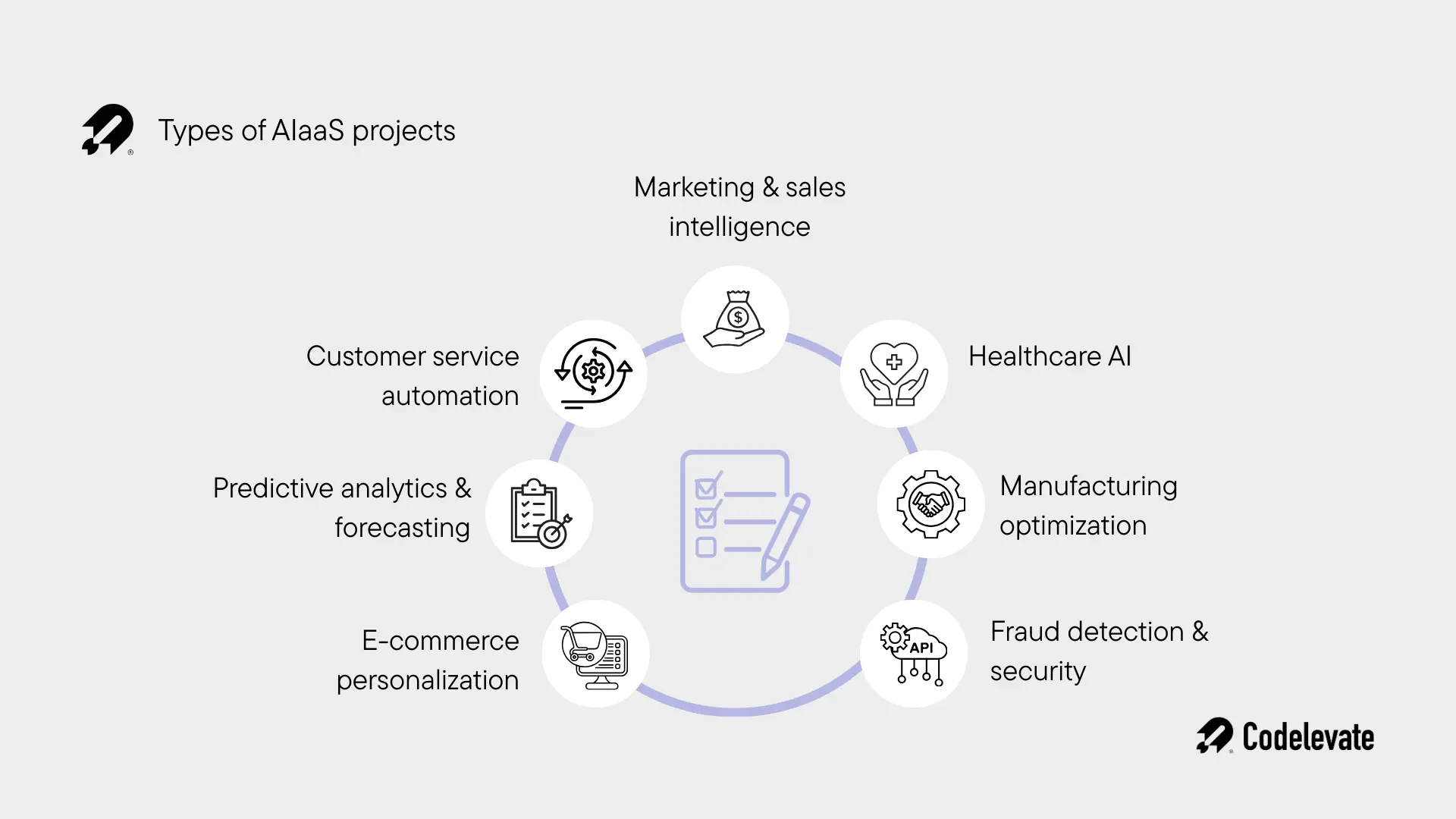
What types of projects and industries can benefit from SDaaS?
Software Development as a Service (SDaaS) can support a wide variety of projects and industries by complementing your in-house team with specialized software expertise.
- Startups and small businesses: Quickly build MVPs, prototypes, and apps without large upfront costs.
- Enterprises: Modernize legacy systems, integrate new tech, or scale development capacity during high-demand periods.
- Web and mobile apps: Develop responsive websites, hybrid or native mobile apps, and progressive web apps (PWAs).
- SaaS and e-commerce: Ensure ongoing product updates, bug fixes, and scalable solutions for online platforms.
- Healthcare and manufacturing: Develop telehealth solutions, inventory systems, or production workflow software with advanced tech like IoT or AI analytics.
- Fintech: Improve cybersecurity, data management, and compliance for apps handling sensitive financial data.
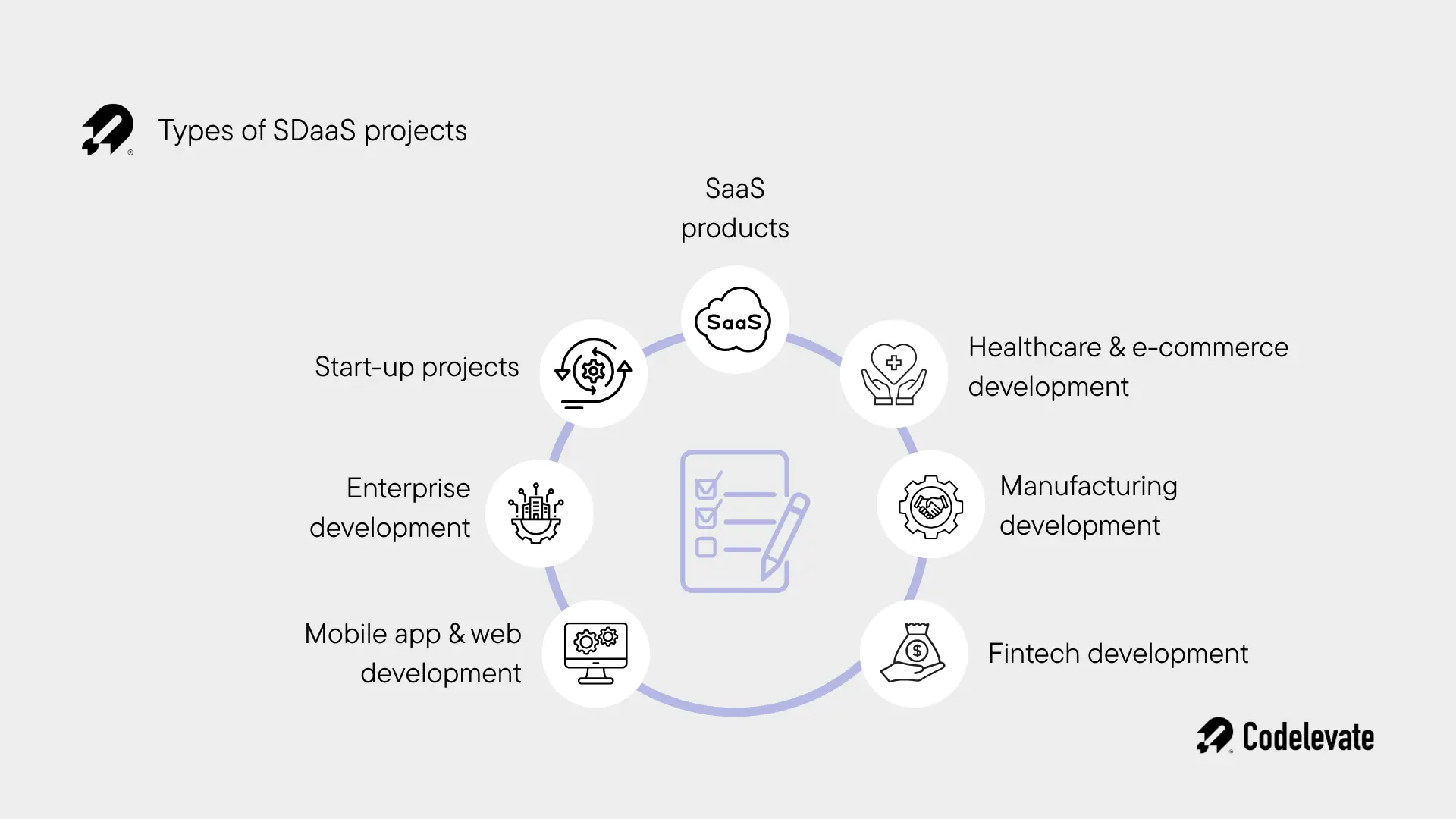
Which one should you choose in 2025?
The answer depends on your business goals. If you want to harness the power of AI quickly—whether it’s improving customer service, automating workflows, or making better use of your data—AIaaS is your best bet. But if your core challenge is building, scaling, or modernizing software itself, SDaaS is the smarter path. In fact, many forward-looking businesses in 2025 are combining both models: using AIaaS tools inside the software they build with SDaaS teams. Think of it like building a car. SDaaS provides the engineers who design and assemble the car itself, while AIaaS provides the smart features inside—like autonomous driving, predictive maintenance, or navigation. Together, they create a more powerful outcome. Some real-world examples include:
- AIaaS in action: A retail company uses AIaaS to forecast demand, reducing overstock and avoiding shortages. A startup integrates AI chatbots through IBM Watson Assistant instead of hiring a natural language processing expert.
- SDaaS in action: A fintech company works with an SDaaS provider to modernize legacy banking systems. An enterprise partners with an SDaaS team to develop a new mobile app for customer engagement.
If you want to learn more why the SDaaS model is ideal for startups, read this blog article.
Conclusion
Both AIaaS and SDaaS represent the next chapter in outsourcing—one that’s flexible, scalable, and designed for the fast-moving digital economy of 2025. The question isn’t really “which one is better?” but rather “how can my business best combine them?” By leveraging AIaaS, you unlock the intelligence of machine learning and automation without the complexity of building it all yourself. By adopting SDaaS, you gain the ability to develop software faster, cheaper, and more strategically. Together, they give businesses a powerful toolkit to stay ahead in a world where technology changes by the day. And in 2025, the choice between AIaaS and SDaaS—or both—may very well define which businesses thrive in the years ahead.
Boost your business with on-demand software development
In today’s fast-paced digital world, partnering with a trusted software development provider is no longer just a backup plan—it’s a strategic move. Software Development as a Service (SDaaS) gives companies of all sizes and industries a cost-effective, flexible way to tap into technical expertise on demand, streamline development, and stay focused on their core business.
At Codelevate, we specialize in delivering end-to-end software development solutions tailored to your needs. From the first line of code to long-term maintenance and updates, our team works closely with you to ensure your projects succeed. By leveraging SDaaS, our mission is to help businesses not only achieve their software goals but also build a lasting partnership centered on real, measurable business value. Book a call with our experts today and let's turn your vision into reality!


.webp)

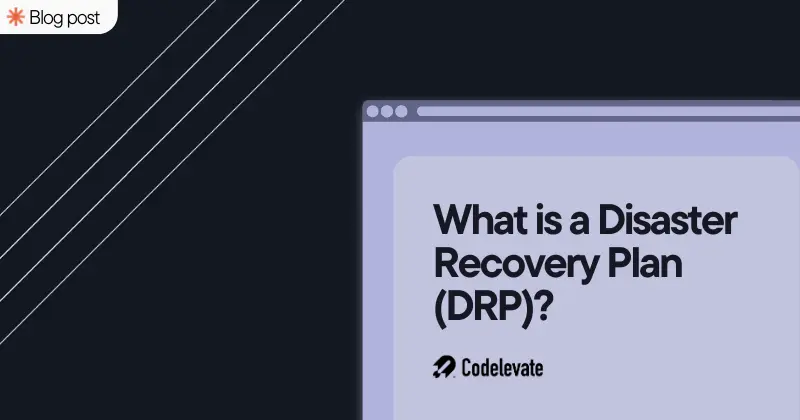
.svg)




